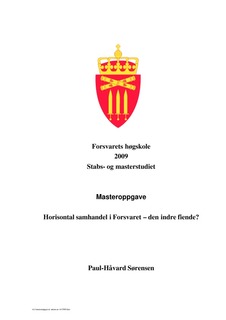| dc.description.abstract | This study examines advantages and disadvantages with internal markets and different degrees of internal trading of services and supplies in the Norwegian Armed Forces. Different degrees of internal trading in armed forces relate mainly to the grade of internal pricing and centralised versus decentralised management of internal trading. The policy of internal pricing is common, but the level of management of internal markets varies between military capabilities and services. Overall, the support side, consisting of the Norwegian Defence Logistic Organisation and Norwegian Defence Estates Agency, seem to have advantages with this model, independent from degree of internal trading. On the other side, the operational side seems generally to have disadvantages with the internal markets. Furthermore, significant disadvantages were discovered for the units that have decentralised management. Additionally the organisation model derived by the process of creating internal markets seems to have some negative effects on the efficiency of the operational capabilities. The recommendation is to compensate the internal markets with more vertical management and less internal pricing. In addition, a restrictive policy of decentralised organisation of the internal markets seems to mitigate the negative effects. | en_US |
